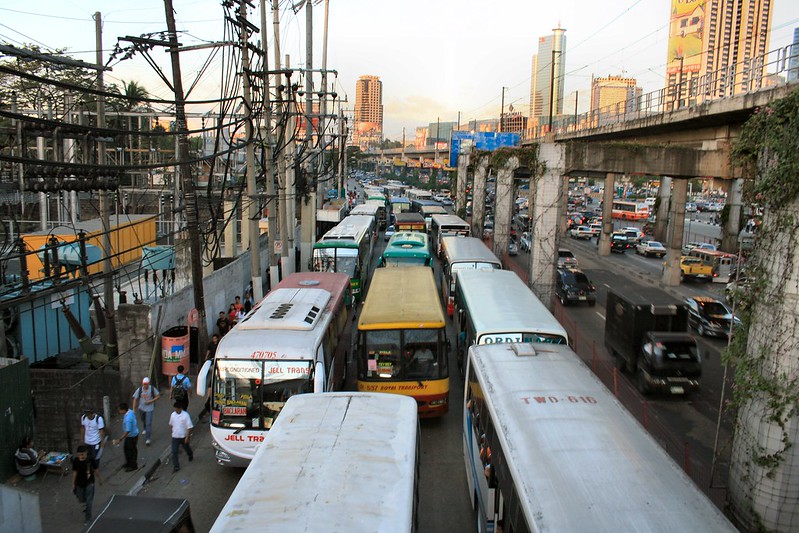News
Waze’s review of Manila’s traffic condition ‘a waste’: Palace

Panelo said Waze should also take into consideration the traffic problems in other countries, before arriving at a conclusion that Metro Manila has the worst traffic condition all over the world.
(File photo: Chris Griffin/Flickr, CC BY-NC-ND 2.0)
MANILA — It was a “waste” for traffic navigation application Waze to assess Metro Manila as the world’s “worst city” for motorists, Malacañang said on Wednesday.
In a chance interview with Palace reporters, Presidential Spokesperson Salvador Panelo shrugged off the assessment of Waze, which he claimed is not a reliable application when it comes to route details.
“Kung minsan naman, ‘yung Waze, it’s almost a waste. When I use it, lalo akong napatagal. Mas marunong pa ako sa Waze sa mga lugar (Sometimes, Waze is almost a waste. When I use it, it takes me longer to arrive in my destination. I have more knowledge of driving directions than Waze),” he said.
It took 4.9 minutes to drive one kilometer in the Philippine capital, according to Waze’s September 2019 data published in a report by Bloomberg.
Waze Philippines head Sarah Rodriguez, in an interview with Bloomberg, said Metro Manila will most likely hold the title of the world’s worst city to drive in for the second consecutive year, based on its 2019 ranking.
Waze’s review came amid the public’s renewed calls for President Rodrigo Duterte’s administration to provide solutions to the country’s traffic woes.
Panelo said Waze should also take into consideration the traffic problems in other countries, before arriving at a conclusion that Metro Manila has the worst traffic condition all over the world.
”Before you can say that, you have to go to other countries that are listed to be worst traffic countries para (so) you can compare. Otherwise, (the claim about Metro Manila’s traffic situation is not true),” he said, when asked if the Palace attests that there is truth to Waze’s report.
No choice but endure traffic jams
Shortly after taking a four-hour commute challenge on October 11, Panelo denied that there is a “mass transport crisis” but admitted that there is a “traffic crisis.”
In his latest remarks, the Palace official said motorists and riders have “no choice” but to bear the brunt of traffic chaos in Metro Manila.
He also reiterated that the public must be “creative” to survive the congested traffic in the country’s metropolis.
“Eh talaga naman, ‘di ba lahat tayo nagre-reklamo sa traffic situation. Hindi tayo nakakarating sa oras, unless mag-allot tayo ng allowance ng two to three hours (All of us are really complaining about the traffic situation. We would not be able to arrive on time, unless we allot an allowance of two to three hours to travel),” Panelo said.
“Ang hirap sumakay ng mga ordinaryong tao. Nakikita nating may mga pumipila. Kumbaga wala kang choice kasi kung… May choice ka ba kung nahihirapan kang sumakay (Ordinary people find it difficult to commute. They have to endure the long lines. Meaning, you have no choice. Do you have a choice when you find it difficult to take a public transportation)?” he added.
Infra projects to ease traffic congestion
The Duterte administration has assured the public that its ambitious “Build, Build, Build” infrastructure program would help address the perennial problems of traffic jams in Metro Manila.
In June this year, the President vowed to secure a five-minute travel time between Cubao and Makati for commuters and drivers by yearend.
Panelo said the completion of the current administration’s infrastructure projects would decongest traffic in the country’s capital.
“Aba, kung gawa na ang mga project natin, malaking kainaman (If our projects are completed, it would be of big help),” he said.
Panelo, explained that Duterte’s promise of shorter travel time between Cubao and Makati by end of December is premised on the completion of all infrastructure projects.
“Syempre ‘yung sinabi niya on the assumption na ‘yung mga project matatapos on time (Of course, his statement is based on the assumption that the projects will be done on time),” he said, when pressed if the President’s pledge is attainable.





















